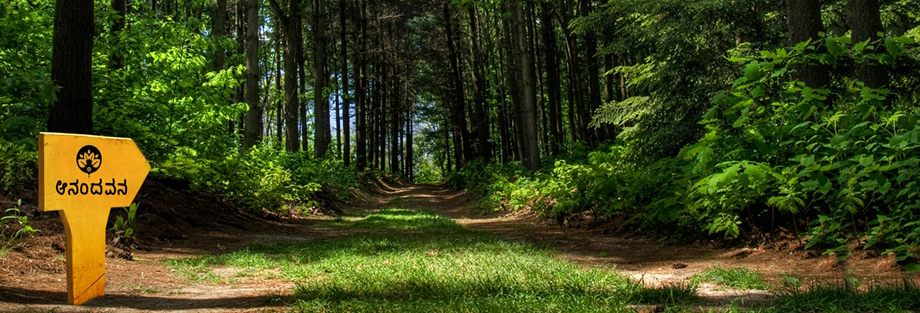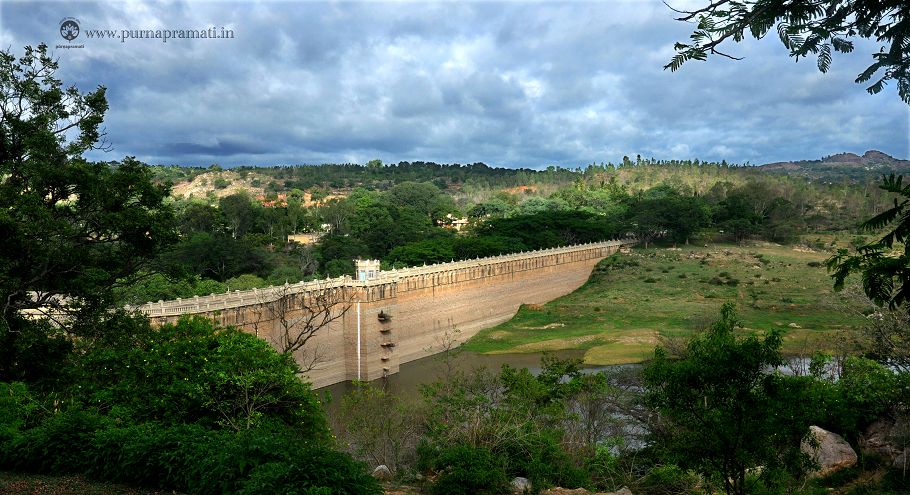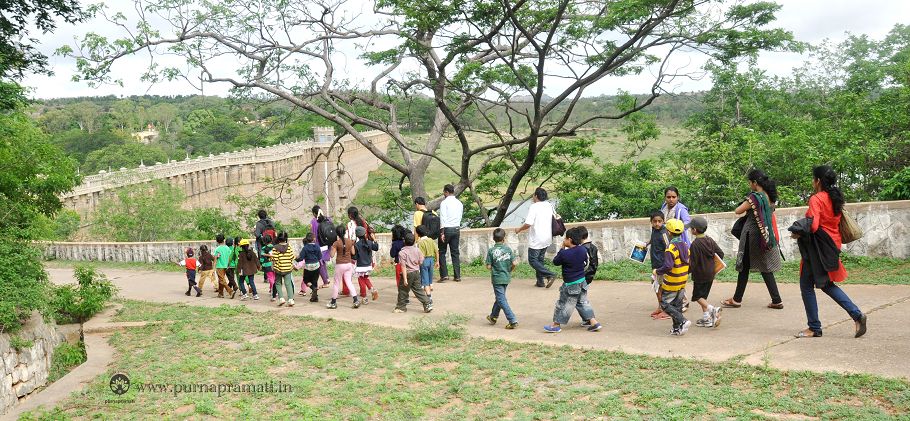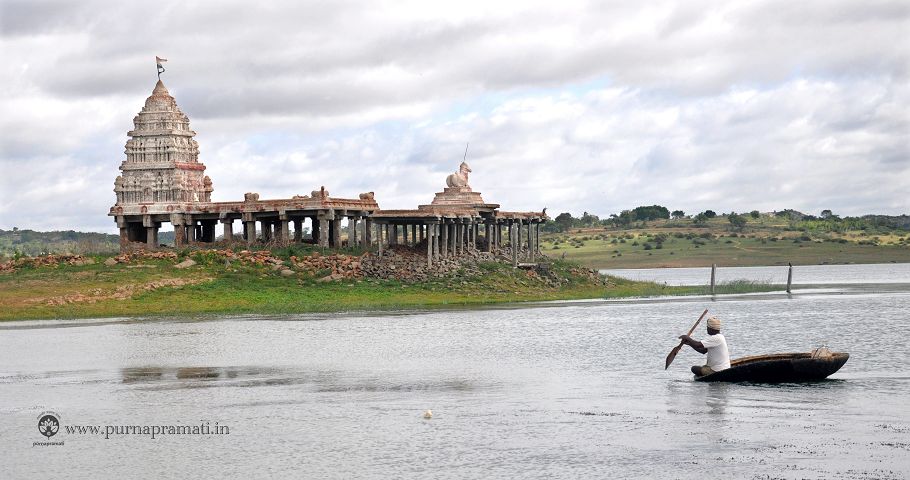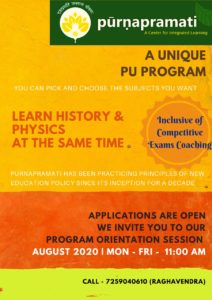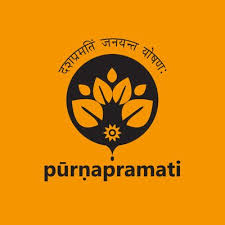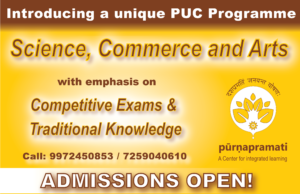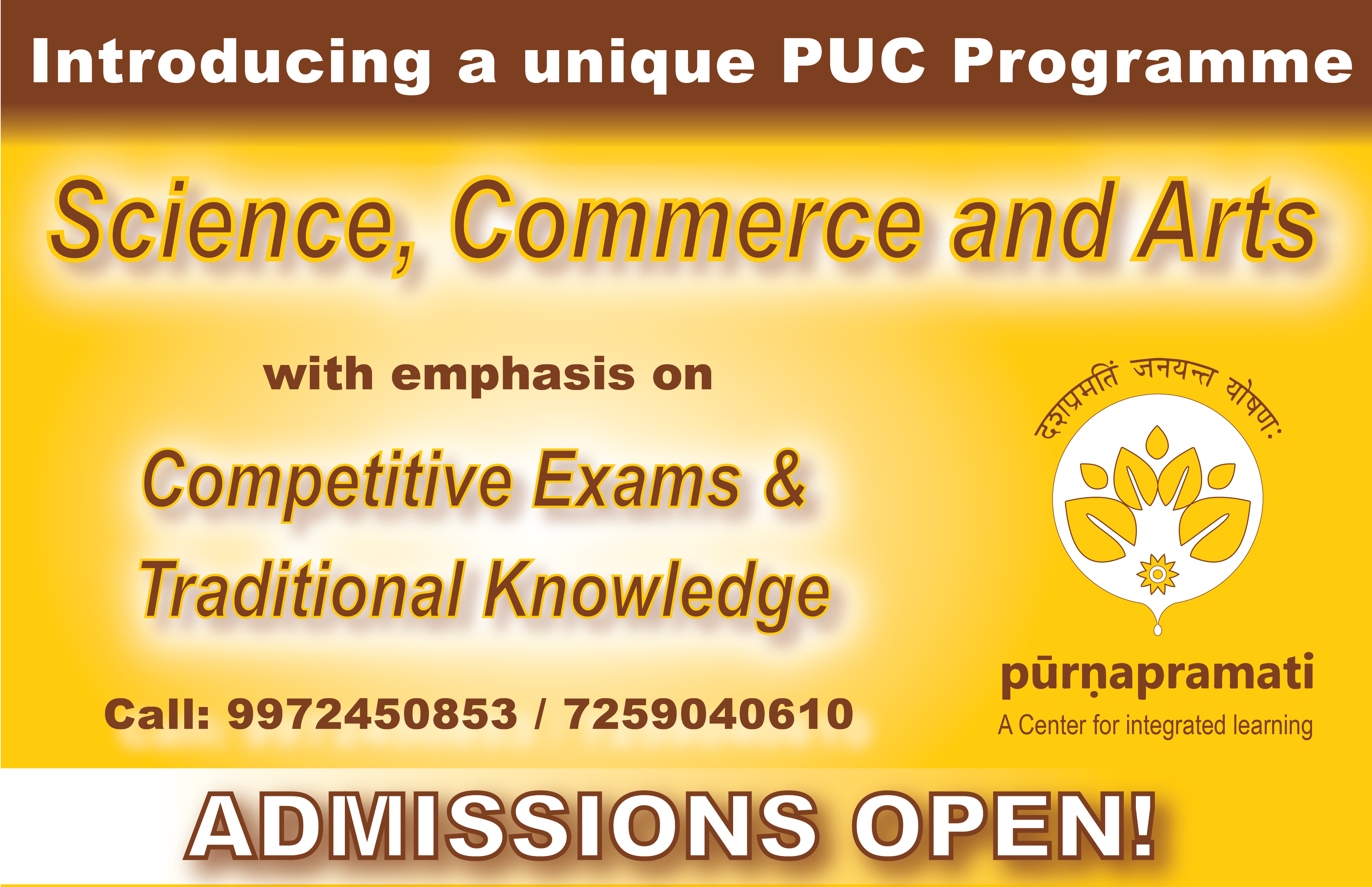Bhageerati Jayanti – 2013
After a yearlong effort of understanding the River as one of the most necessary life sustainers , this year we have proceeded with our thematic learning focusing on the inter reliance of lives in the world. And on this theme weekly classes are being conducted in the campus. But how can anybody appreciate the variety of lives, their habitats and network without experiencing the least contact with them? Hence our field trip to Tippagondanahalli, a place where the rivers Kumudvati and Arkavati meet which is a habit for a large variety of birds. Just adjacent to the meeting point of the two rivers, the flow is blocked by Chamrajasagar reservoir built by the British during 1933 under the supervision of Sir. M Vishveshvaraih to supply piped water to their establishment and other parts of Bangalore. The reservoir has supplied about 35 million liters of water per day to Bangalore for more than thirty years and hence it is also a place of historical significance to Bangalorians. However water supply from the reservoir to any place has stopped and the reservoir remains dry or holds little water during most months.
Two bird watchers Mr. Srinivasa Rao and Mr Ullas Anand accompanied us as guides. As we began to stroll along the paths amidst plantation, almost once in every two footsteps, they spotted a species of a plant or an insect or a bird and explained it’s attributes. Some of the aspects that came to light in their conversation with children are here:
- Etymology of the word Tamarind – When the Arabs visited India and saw Tamarind trees unfamiliar to them, the fruit part appeared similar to dates which they call ‘Tamarai’. So they called it ‘Tamarai-Hind’- The Dates of India. Later, the British modified it as Tamarind to their convenience.
- Sandlewood tree – In any grown up tree there are two kinds of tissues- The Xylem and The Phloem. Xylem is marketed as hard wood after the tissue dies and sandlewood tree requires a period of 20 years to develop fragrance.
- Anthill- Anthills are not made by snakes which live in them. They are made by Moths(insects that are attracted to light). They are social animals which categorize as queens- the individuals that lay eggs, workers- those which work for food and soldiers- those which work for protection. They collect leaves, harvest fungi on them and then feed on them. When these insects leave the place, snakes, which are cold blooded take shelter in them to protect themselves from the sun. The anthills being mud structures act as natural air conditioners(convention cycle- hot air goes up and cold air comes down) and are pleasant to snakes. Are they spacious enough for a group of snakes to live? Yes. A quite old ant hill is about 25 to 30 feet deep below the ground and the volume of an ant hill is directly proportional to its age.
- Emigrant butterfly – They migrate when it rains.
- Bonnet monkey – These are monkeys whose head look like a car bonnet and are commonly found in South India. In the northern parts of India the commonly found monkey kind is the Rhesus monkey. Humans must owe a lot to those monkeys because they are the first ones to alert scientists about the presence of Rh factor in human blood neglecting which blood transfusions could become fatal. Rh factor means Rhesus factor.
- Some more introductions – Basavana pada or Bahunia or Kanchuvala tree whose leaves look like Oxe’s hooves. Plumeria or Devakanigile or Temple tree popularly found in temple premises.(Old Plumeria trees can be found in Virupaksha temple at Hampi). Epiphytes are plants that grow upon other plants non-paracitically( without drawing food out of them). Insects are six legged and arachnids are eight legged. They are together called arthropods.
For more photos please click here
Oxygen reduction, algae bloom, toxicity, increased temperature make water hazardous to life and water pollution is the most common crisis nowadays. So, to ensure a healthy eco-system the society needs to learn to check these parameters in water. With this in mind, we had organized a water testing session for the day. Dr Iqbal and Dr Deepesh – scientists from CPCB demonstrated a few tests for chemical and physical parameters of water purity. The details are given below –
Water was collected from the lake(Reservoir) Children observed the color and odor of the collected water. A pH paper was dipped in the water and children compared the color of the pH paper with a color code. A test for Turbidity(Relative clarity of water) was conducted using Secchi disc(A black and white disc) method- clearer the visibility of the disc inside, purer the water. Children titrated and found out the content of dissolved oxygen in the water. They learnt about the hardness of water and titrated the water against EDTA solution using Erichrome black – T – indicator.
We then visited Spoorthy Vana situated at an extent of about half a kilometer from the place. It is a forest looked after by a group of committed horticulturists led by Mr Eshwar Prasad. Children enacted three short plays – one conveying the commitment of all animals to their activities, another on the life style of forest dwellers and the last one on chipko movement – a non violent resistance of the people through hugging trees to protect them from being felled. Children planted about a dozen of trees in the Spoorthy vana before leaving the place.
Our field trip ended with a very creative game modeling the birth of aquatic animals like turtles, their reaching to the water from the place where they hatch and the life threats they face on their way to water.
Thus on Bhagirathi Jayanthi Purnapramati successfully completed its first field trip of the year relevant to the year’s theme jivo jivasya jivanam and also to that of the previous year jivanam jalam uchyate.
ಪೂರà³à²£à²ªà³à²°à²®à²¤à²¿à²¯à²²à³à²²à²¿à²‚ದೠà²à²¾à²—ೀರಥಿ ಜಯಂತಿ…. ಮಕà³à²•à²³à³Šà²‚ದಿಗೆ ಹೆಜà³à²œà³† ಹಾಕà³à²¤à³à²¤à²¾…
ಇಂದೠಜೇಷà³à² ಮಾಸ, ಹಸà³à²¤ ನಕà³à²·à²¤à³à²°, ನವಮಿ ತಿಥಿ…. ನದಿಗಳೠತಮಗೊಂದೠದಿನ, ಜಯಂತಿ ಮಾಡಿರೆಂದೠಬೇಡಿಕೊಳà³à²³à³à²µà³à²¦à²¿à²²à³à²². ಆದರೆ ಅವà³à²—ಳ ಮೂಲಕ ಮಕà³à²•à²³à²¿à²—ೆ ಆ ದಿನದ ಮಹತà³à²µ, ಹಿನà³à²¨à²²à³†, ಸà³à²®à²°à²£à³€à²¯à²° ಬಗà³à²—ೆ ಜಾಗೃತಿಯನà³à²¨à³ ಮೂಡಿಸà³à²µà³à²¦à³ ನಮà³à²® à²à²¾à²—ೀರಥಿ ಜಯಂತಿಯ ಉದà³à²¦à³‡à²¶. à²à²—ೀರಥನಿಗೆ ಗಂಗೆಯನà³à²¨à³ à²à³‚ಮಿಗೆ ತರಬೇಕಿತà³à²¤à³, ದೃಢಚಿತà³à²¤à²¨à²¾à²—ಿ ಬೇಡಿದ. à²à³‚ಮಿಗೆ ಬಂದ ಗಂಗೆಯನà³à²¨à³ ರಕà³à²·à²¿à²¸à²¿à²•à³Šà²³à³à²³à²²à³ ದೃಢಮನಸà³à²•à²°à²¾à²—ಿ ದà³à²¡à²¿à²¯à³à²µ ಹೊಣೆ ನಮà³à²®à²¦à³. ಅದಕà³à²•à²¾à²—ಿ ಈ à²à²¾à²—ೀರಥಿ ಜಯಂತಿ.
ಮಕà³à²•à²³à²¿à²—ೆ ಕಳೆದ à²à²¾à²—ೀರಥಿ ಜಯಂತಿಯಂದೠಕà³à²®à³à²¦à³à²µà²¤à²¿à²¯ ಜನà³à²®à²¸à³à²¥à²³à²µà²¨à³à²¨à³ ತೋರಿಸಲಾಗಿತà³à²¤à³. ಇಂದೠಅರà³à²•à²¾à²µà²¤à²¿à²—ೆ ಸೇರà³à²µ ತಾಣವನà³à²¨à³ ತೋರಿಸà³à²µ ಇಚà³à²šà³†à²¯à²¿à²‚ದ ಬೆಂಗಳೂರೠಗà³à²°à²¾à²®à²¾à²‚ತರ ಜಿಲà³à²²à³†à²¯ ತಾವರೆಕೆ ತಾಲà³à²²à³‚ಕಿನ ತಿಪà³à²ªà²—ೊಂಡನ ಹಳà³à²³à²¿à²•à³†à²°à³†à²—ೆ ಬೇಟಿನೀಡಲಾಯಿತà³. ಮಾಗಡಿ ರಸà³à²¤à³†, ಜೋಗೇನ ಹಳà³à²³à²¿ ಮಾರà³à²—ವಾಗಿ ಸಾಗಿದರೆ ಬೆಂಗಳೂರೠನಗರದಿಂದ ಕೇವಲ ಒಂದೠಗಂಟೆಯ ಸಮಯದಲà³à²²à²¿ ತಿಪà³à²ªà²—ೊಂಡನ ಹಳà³à²³à²¿ ಕೆರೆಯನà³à²¨à³ ಮà³à²Ÿà³à²Ÿà²¬à²¹à³à²¦à³. ೧೯೩೩ ರಿಂದ ೧೯à³à³¦ ರವರೆಗೆ ಬೆಂಗಳೂರಿನ ಜನರಿಗೆ ಕà³à²¡à²¿à²¯à²²à³ ನೀರà³à²£à²¿à²¸à²¿à²¦à³à²¦ ತಿಪà³à²ªà²—ೊಂಡನ ಹಳà³à²³à²¿ ಕೆರೆಯೠಇದೀಗ ಬೆಂಗಳೂರಿನವರ ಅತಿಯಾದ ದಾಹವನà³à²¨à³ ತೀರಿಸಲೠಸಾಧà³à²¯à²µà²¾à²—à³à²¤à³à²¤à²¿à²²à³à²². ಬೆಳಗà³à²—ೆ à³.೪೦ಕà³à²•à³† ನಾವೆಲà³à²²à²°à³ ಬೆಂಗಳೂರೠನೀರೠಸರಬರಾಜೠಮತà³à²¤à³ ಒಳಚರಂಡಿ ಇಲಾಖೆಯೠನಿರà³à²µà²¹à²¿à²¸à³à²¤à³à²¤à²¿à²°à³à²µ ಚಾಮರಾಜ ಸಾಗರ ವಾಟರೠಟà³à²°à³€à²Ÿà³â€Œà²®à³†à²‚ಟೠಪà³à²²à²¾à²‚ಟà³à²¨à³à²¨à³ ತಲà³à²ªà²¿à²¦à³†à²µà³. ಪರಿವೀಕà³à²·à²£ à²à²µà²¨à²¦à²²à³à²²à²¿ ಈಶà³à²µà²°à³ ಪà³à²°à²¸à²¾à²¦à²°à³ ನಮà³à²®à²¨à³à²¨à³ ಎದà³à²°à³à²—ೊಂಡೠವಿವರಗಳನà³à²¨à³ ನೀಡà³à²¤à³à²¤à²¾ ಮà³à²‚ದà³à²µà²°à³†à²¦à²°à³.
ಸಮà³à²¦à³à²°à²®à²Ÿà³à²Ÿà²•à³à²•à²¿à²‚ತ ೨೫à³à³¦ ಅಡಿ ಎತà³à²¤à²°à²¦à²²à³à²²à²¿à²°à³à²µ ಇದೠಕಾವೇರಿ ಜಲಾನಯನ ಪà³à²°à²¦à³‡à²¶à²µà²¾à²—ಿದೆ. ವಿಶà³à²µà³‡à²¶à³à²µà²°à²¯à³à²¯à²¨à²µà²° ವೈಜà³à²žà²¾à²¨à²¿à²•, ಕà³à²°à²®à²¬à²¦à³à²§à²µà²¾à²¦ ಅಣೆಕಟà³à²Ÿà²¿à²¨ ಯೋಜನೆ ನೀರಿನ ಸಂಗà³à²°à²¹à²£à³†à²—ೆ ಇಂದಿಗೂ ಸಹಕಾರಿಯಾಗಿದೆ. ಇದರ ಒಟà³à²Ÿà³ ಶೇಕರಣ ಸಾಮರà³à²¥à³à²¯ ೨೫೪ೠಅಡಿ. ೪ ಪà³à²°à²®à³à²– ತೂಬà³à²—ಳಿವೆ. ೧೯೩೩ ರಲà³à²²à²¿ ಬೆಂಗಳೂರಿಗೆ ನೀರನà³à²¨à³ ತರà³à²µ ಯೋಚನೆ ಮಾಡಿದಾಗ ಹೇಮಾವತಿ, ಕಾವೇರಿ ನದಿಗಿಂತ ಸà³à²²à²à²µà²¾à²—ಿ ನೀರನà³à²¨à³ ಒದಗಿಸಲೠಮà³à²‚ದಾದ ಅರà³à²•à²¾à²µà²¤à²¿ ಮತà³à²¤à³ ಕà³à²®à³à²¦à³à²µà²¤à²¿ ನದಿಗಳ ಸಂಗಮವಾದ ಇದೇ ತಿಪà³à²ªà²—ೊಂಡನ ಹಳà³à²³à²¿ ಕೆರೆ.
ಮà³à²‚ದೆ ನಾವೆಲà³à²²à²°à³ ಈ ಪà³à²°à²¦à³‡à²¶à²¦à²²à³à²²à²¿ ಬೆಳೆಯà³à²µ ಸಸà³à²¯à²—ಳà³, ಪಕà³à²·à²¿à²—ಳನà³à²¨à³ ವೀಕà³à²·à²¿à²¸à³à²¤à³à²¤à²¾ ಅಣೆಕಟà³à²Ÿà³ ಮಾರà³à²—ವಾಗಿ ಮà³à²‚ದà³à²µà²°à³†à²¦à³†à²µà³. ಜಲಶà³à²¦à³à²§à³€à²•à²°à²£ à²à²µà²¨à²µà²¨à³à²¨à³ ಕಂಡೆವà³. ಕರà³à²¨à²¾à²Ÿà²• ರಾಜà³à²¯ ಮಾಲಿನà³à²¯ ನಿಯಂತà³à²°à²£ ಮಂಡಳಿಯಿಂದ ಬಂದಂತಹ ವಿಜà³à²žà²¾à²¨à²¿à²—ಳೠನಮà³à²® ಮಕà³à²•à²³à²¿à²—ೆ ಕೆರೆಯ ತೀರದಲà³à²²à²¿ ನೀರಿನ ಪರೀಕà³à²·à³†à²¯à²¨à³à²¨à³ ಹೇಗೆ ನಡೆಸಬಹà³à²¦à³†à²‚ಬ ಪà³à²°à²¯à³‹à²—ವನà³à²¨à³ ಮಾಡಿ ತೋರಿಸಿದರà³. ಮಕà³à²•à²³à²¿à²—ೆ ಅರà³à²¥à²µà²¾à²—à³à²µ ಸà³à²²à² à²à²¾à²·à³†à²¯à²²à³à²²à²¿ ವಿವರಿಸà³à²¤à³à²¤à²¾ ಪà³à²°à²¯à³‹à²—ವನà³à²¨à³ ಮಾಡಿ ತೋರಿಸಿದರà³. ಎಲà³à²²à²¾ ವಿವರಗಳನà³à²¨à³ ಒಳಗೊಂಡ ಕೈಪಿಡಿಯನà³à²¨à³ ಮತà³à²¤à³ ನೀರಿನ ಪರೀಕà³à²·à³†à²¯ ಸಲಕರಣೆಗಳ ಪೆಟà³à²Ÿà²¿à²—ೆಯನà³à²¨à³ ಶಾಲೆಗೆ ಕೊಡà³à²—ೆಯಾಗಿ ನೀಡಿದà³à²¦à²¾à²°à³†. ನೀರಿನ ಪರೀಕà³à²·à³†à²¯à²¿à²‚ದ ನದಿಯ ಉದà³à²¦, ಆಳ, ಮಣà³à²£à²¿à²¨ ಗà³à²£à²—ಳನà³à²¨à³ ತಿಳಿಯಬಹà³à²¦à³. ಪರೀಕà³à²·à³†à²—ಾಗಿ ಬಳಸà³à²µ ನೀರೠನದಿಯ ಮಧà³à²¯à²à²¾à²—ದà³à²¦à²¾à²—ಿದà³à²¦à²°à³† ಒಳಿತà³.(ಆಸಕà³à²¤à²°à³ ವಿವರಗಳನà³à²¨à³ ಕೈಪಿಡಯಲà³à²²à²¿ ಓದಿ ತಿಳಿಯಬಹà³à²¦à³, ಶಾಲೆಯಲà³à²²à²¿ ಲà²à³à²¯à²µà²¿à²¦à³†) ಇವರ ಪà³à²°à²•à²¾à²° ಮೂರೠಮà³à²–à³à²¯ ಕà³à²·à³‡à²¤à³à²°à²—ಳಲà³à²²à²¿ ನೀರಿನ ಪರೀಕà³à²·à³†à²¯à²¨à³à²¨à³ ನಡೆಸಲಾಗà³à²µà³à²¦à³. ಅವà³:
1. Physical parameters
– Colour
– Odour
– Temperature
– Turbidity
– Suspended Solids
2. Chemical Parameters
– pH
– Alkalinity
– Dissolved Oxygen
– Hardness
– Calcium
– Fluride
– Nitrate
– Ammonia
– Phosphate
– Total Iron
– Residual Chlorine
3. Biological Parameters
– Estimation of Total Coliform
– Estimataion of Primary Productivity
– Estimation of Water Quality usig Benthic Macro-invertebrates (Benthic Animals)
ಇವà³à²—ಳ ಪರೀಕà³à²·à³†à²¯à²¨à³à²¨à³ ನಡೆಸಿದ ನಂತರ ಬಳಕೆಗೆ ಸೂಕà³à²¤à²µà³†à²‚ದೠತಿಳಿಯಲಾಗà³à²µà³à²¦à³ ಎಂಬ ಅಂಶವನà³à²¨à³ ವಿವರಿಸಿದರà³. ಮಕà³à²•à²³à³ ಪà³à²Ÿà³à²Ÿ ವಿಜà³à²žà²¾à²¨à²¿à²—ಳಂತೆ ಇನà³à²¨à³ ಮà³à²‚ದೆ ಶಾಲೆಯಲà³à²²à²¿, ಮನೆಯಲà³à²²à²¿ ನೀರಿನ ಪರೀಕà³à²·à³† ನಡೆಸಿಯೇ ಬಳಸà³à²µà³à²¦à²¾à²—ಿ ಪಣತೊಟà³à²Ÿà²°à³.
ಅಲà³à²²à²¿à²‚ದ ಸà³à²«à³‚ರà³à²¤à²¿à²µà²¨à²•à³à²•à³† ನಮà³à²® ತಂಡ ನಡೆಯಿತà³. ಈಶà³à²µà²°à³ ಪà³à²°à²¸à²¾à²¦à²°à³ ಸೀಮಾರೂಪ, ಹಿಪà³à²ªà³†, ನಾಯಿ ನೇರಳೆ- ಮಹಾಘನಿ (ದಕà³à²·à²¿à²£ ಅಮೇರಿಕದಿಂದ ಬಂದ ತಳಿಗಳà³), à²à²‚ ನೇರಳೆ, ಗೊಣà³à²£à³† ಹಣà³à²£à²¿à²¨ ಮರ, ಹಳೆ ಮತà³à²¤à²¿, ಮರಾಲೆ, ಬೇಲ, ಮà³à²¤à³à²¤à³à²—ದ ಮರ, ಛತà³à²°à²¿à²®à²°, ಬಾಗೇಮರ, ಹೊಂಗೆಮರ, ತಾರೆಮರ ಮತà³à²¤à³ ಮರಗಳಲà³à²²à³‡ à²à³€à²·à³à²® ಪಿತಾಮಹನೆಂಬ ಹೆಸರೠಪಡೆದಿರà³à²µ ಹà³à²£à²¸à³† ಮರದ ಸಸಿಗಳನà³à²¨à³ ಪರಿಚಯಿಸಿ ಅವà³à²—ಳ ಎತà³à²¤à²°, ಒಟà³à²Ÿà³ ಜೀವನಾವಧಿ, ಗà³à²£à²—ಳನà³à²¨à³ ವಿವರಿಸಿದರà³. ಮಕà³à²•à²³à³ ಕà³à²¤à³‚ಹಲದಿಂದ ಪà³à²°à²¶à³à²¨à³†à²—ಳನà³à²¨à³ ಕೇಳಿ ಮಾಹಿತಿಯನà³à²¨à³ ಪಡೆದರà³. ಹà³à²£à²¸à³‡ ಮರದ ಕೆಳಗೆ ಕà³à²³à²¿à²¤à³ ಅವà³à²—ಳನà³à²¨à³ ಮಾತನಾಡಿಸಿದರೆ ಎಷà³à²Ÿà³‹ ಹಿಂದನ ಕತೆಗಳನà³à²¨à³ ಅವೠಹೇಳà³à²¤à³à²¤à²µà³†, ನಾವೠಕೂತೠಅದರೊಂದಿಗೆ ಮಾತನಾಡಬೇಕೆಂದೠಪà³à²°à²•à³ƒà²¤à²¿à²—ೆ ಹತà³à²¤à²¿à²°à²µà²¾à²—à³à²µ ಮಾರà³à²—ವನà³à²¨à³ ತೋರಿಸಿದರà³.
ಸೀಮಾರೂಬ, ಹೊಂಗೆಮರಗಳಿಂದ ಬಯೋಡೀಸೆಲೠತಯಾರಿಸಲೠಪà³à²°à²¯à³‹à²—ಗಳನà³à²¨à³ ನಡೆಸಲಾಗà³à²¤à³à²¤à²¿à²¦à³†. ಗೊಂಬೆಗಳ ತಯಾರಿಯಲà³à²²à²¿ ಮರಾಲೆ ಮರವೠಬಹಳ ಉಪಕಾರಿಯಾಗಿದೆ. ಜನರಲà³à²²à²¿ ಜಾಗೃತಿಯನà³à²¨à³ ಮೂಡಿಸà³à²µ ಸಲà³à²µà²¾à²—ಿ ಹà³à²Ÿà³à²Ÿà³à²¹à²¬à³à²¬, ಮದà³à²µà³† ಇತà³à²¯à²¾à²¦à²¿ ಸಮಾರಂà²à²—ಳ ನೆನಪಿಗಾಗಿ ಒಂದೊಂದೠಸಸಿಯನà³à²¨à³ ನೆಡà³à²¤à³à²¤à²¾ ಇಂದೠಸà³à²«à³‚ರà³à²¤à²¿à²µà²¨ ಪà³à²Ÿà³à²Ÿ ಕಾಡಿನಂತೆ ಕಂಗೊಳಿಸà³à²¤à³à²¤à²¿à²¦à³†. ಡಾ.ಲಿಂಗರಾಜೠಅವರೠಅದೇ ಸಮಯಕà³à²•à³† ನಮà³à²® ತಂಡದೊಂದಿಗೆ ಸೇರಿ à²à²¦à²¾à²°à³ ಗಿಡಗಳನà³à²¨à³ ಮಕà³à²•à²³à³Šà²‚ದಿಗೆ ನೆಟà³à²Ÿà²°à³. ಸಸಿಯನà³à²¨à³ ನೆಡà³à²µà³à²¦à³ ಒಂದೠಹೆಜà³à²œà³†. ಅವà³à²—ಳನà³à²¨à³ ಮಕà³à²•à²³à²‚ತೆ ಸಾಕಿ ಸಲà³à²¹à²¿ ಬೆಳೆಸà³à²µ ಹೊಣೆ ಹೊತà³à²¤à²¿à²°à³à²µ ಈಶà³à²µà²°à³ ಪà³à²°à²¸à²¾à²¦à³ ಮತà³à²¤à³ ಅವರ ತಂಡದವರಿಗೆ ಶಾಲೆಯವತಿಯಿಂದ ಮತà³à²¤à³ ಆಸಕà³à²¤ ಪೋಷಕರಿಂದ ಸಂಗà³à²°à²¹à²¿à²¸à²¿à²¦à³à²¦ ಸಣà³à²£ ಮೊತà³à²¤à²µà²¨à³à²¨à³ ನೀಡಲಾಯಿತà³. ಜೀವೋ ಜೀವಸà³à²¯ ಜೀವನಮೠಸೂತà³à²°à²•à³à²•à³† ಮೊದಲ ಮಣಿಯನà³à²¨à³ ಪೋಣಿಸà³à²µà²‚ತೆ ಮಕà³à²•à²³à³ ಸà³à²«à³‚ರà³à²¤à²¿à²µà²¨à²¦à²²à³à²²à²¿ ಮೂರೠà²à²¿à²¨à³à²¨ ನಾಟಕಗಳನà³à²¨à³ ಪà³à²°à²¦à²°à³à²¶à²¿à²¸à²¿à²¦à²°à³.
ತಮà³à²®à²¦à³‡ ಮಾತà³à²•à²¤à³†à²—ಳಿಂದ ಮೈಮರೆತ ಪà³à²Ÿà²¾à²£à²¿à²—ಳನà³à²¨à³ ಅನಂತಣà³à²£ ಒಂದೠಕà³à²·à²£ ಕಣೠಮà³à²šà³à²šà³à²µà²‚ತೆ ಹೇಳಿ, ಗಾಳಿ-ಪಕà³à²·à²¿à²—ಳ ನಾದಕà³à²•à³† ಕಿವಿಕೊಡà³à²µà²‚ತೆ ಪà³à²°à³‡à²°à³‡à²ªà²¿à²¸à²¿à²¦à²°à³. ಬೆಂಗಳೂರೠನಗರದಲà³à²²à²¿ ಬೇಕೆಂದರೂ ಸಿಗದ ಆ ಸೌಲà²à³à²¯à²µà²¨à³à²¨à³ ಚೆನà³à²¨à²¾à²—ಿ ಅನà³à²à²µà²¿à²¸à³à²µà²‚ತೆ ಮಾಡಿ ಪà³à²°à²•à³ƒà²¤à²¿à²¯à³Šà²‚ದಿಗೆ ಮಾತನಾಡಿಸಿದರà³.
ಕಲಿಕೆ, ಆಟದೊಂದಿಗೆ ಕಲಿಕೆ ಎಂಬಂತೆ ಶಶಿ ಅಣà³à²£ ನಮಗೆಲà³à²²à²°à²¿à²—ೂ ಜೀವಿಸà³à²µà³à²¦à²•à³à²•à²¾à²—ಿ ಹೋರಾಟ ನಡೆಸà³à²µ ಆಟವನà³à²¨à³ ಆಡಿಸಿದರà³. ಮಕà³à²•à²³à³, ಶಿಕà³à²·à²•à²°à³ ಎಲà³à²²à²°à³‚ ಖà³à²·à²¿à²¯à²¿à²‚ದ ಪಾಲà³à²—ೊಂಡರà³, ಆಡಿ ಮತà³à²¤à²·à³à²Ÿà³ ಖà³à²·à²¿à²—ೊಂಡರà³.
ಕಾರà³à²¯à²•à³à²°à²®à²¦ ತಯಾರಿಯನà³à²¨à³ ಮೊದಲಿನಿಂದಲೇ ಆರಂà²à²¿à²¸à²¿à²¦à³à²¦ ಶಾಲೆಯ ಅಧà³à²¯à²¾à²ªà²•à²°à³†à²²à³à²²à²°à³‚ ತಮà³à²® ಜವಾಬà³à²¦à²¾à²°à²¿à²—ಳನà³à²¨à³ ಅಚà³à²šà³à²•à²Ÿà³à²Ÿà²¾à²—ಿ ನಿà²à²¾à²¯à²¿à²¸à²¿à²¦à²°à³. ರà³à²šà²¿à²¯à²¾à²¦ ಅವಲಕà³à²•à²¿, ಬಾಣೆಹಣà³à²£à³à²—ಳನà³à²¨à³ ನೀಡà³à²¤à³à²¤à²¾ ಪà³à²°à²µà²¾à²¸à²¦ ಆಸಕà³à²¤à²¿à²¯à²¨à³à²¨à³ ಮತà³à²¤à²·à³à²Ÿà³ ಹೆಚà³à²šà³à²®à²¾à²¡à²¿à²¦à²°à³. ಶಾಲೆಯ ವà³à²¯à²µà²¸à³à²¥à²¾à²ªà²•à²°à³ ವಾಹನ, ನೀರೠಇತà³à²¯à²¾à²¦à²¿à²—ಳನà³à²¨à³ ಚೆನà³à²¨à²¾à²—ಿ ಅಣಿಗೊಳಿಸಿದà³à²¦à²°à³.
ಪà³à²°à²¸à³à²¤à³à²¤ ತಿಪà³à²ªà²—ೊಂಡನ ಹಳà³à²³à²¿ ಹೆಚà³à²šà³ ಜನರ ವಾಸವಿಲà³à²²à²¦à³† ಮತà³à²¤à²·à³à²Ÿà³ ಮೌನವಾಗಿದೆ. ಜನರೆಲà³à²²à²°à³‚ ಕೆಲಸ, ಜೀವನವನà³à²¨à³ ಅರಸಿ ನಗರ-ಪà³à²°à²¦à³‡à²¶à²—ಳಿಗೆ ವಲಸೆ ಹೋಗಿದà³à²¦à²¾à²°à³†. ಶಾಲೆಗಳೠಬರಿದಾಗಿವೆ. ಈಗೊಂದà³-ಆಗೊಂದೠಬಿ.ಎಂ.ಟಿ.ಸಿ ಬಸೠಓಡಾಡà³à²¤à³à²¤à²¿à²¦à³†. ನಗರಕà³à²•à³‚-ಹಳà³à²³à²¿à²—ೂ ಸೇತà³à²µà³†à²¯à²¾à²—ಿ. ಪà³à²°à²•à³ƒà²¤à²¿ ತನà³à²¨ ನಂಬಿ ಬಂದವರನà³à²¨à³ ಎಂದೂ ಕೈಬಿಡದೆ ಸಲಹà³à²µà²‚ತೆ ಇರà³à²µ ಹಳೆ ತಲೆಮಾರಿನ ಜನರನà³à²¨à³ ಸಾಕà³à²¤à³à²¤à²¾ ಸà³à²‚ದರವಾಗಿದೆ. ಉತà³à²¤à²® ವಾತಾವರಣ, ಕಲಿಕೆಯನà³à²¨à³ ಹೊಂದಿ ನಾವೆಲà³à²²à²°à³‚ ೪.೨೦ಕà³à²•à³† ಅಲà³à²²à²¿à²‚ದ ಹೊರಟೠಸà³à²®à²¾à²°à³ ೫.೩೦ಕà³à²•à³† ಬೆಂಗಳೂರೠತಲà³à²ªà²¿à²¦à³†à²µà³. ಮಕà³à²•à²³à³†à²²à³à²²à²°à³‚ ತಮà³à²® ಅನà³à²à²µà²—ಳನà³à²¨à³ ದಾಖಲಿಸà³à²µà³à²¦à²¾à²—ಿ ಆನಂದದಿಂದ ಮನೆಗಳಿಗೆ ತೆರಳಿದರà³.
ಇದೠನಮà³à²® à²à²¾à²—ೀರಥಿ ಜಯಂತಿಯ ಪಯಣ…ಮಕà³à²•à²³à³Šà²‚ದಿಗೆ ಹೆಜà³à²œà³† ಹಾಕಿದà³à²¦à³‡ ತಿಳಿಯಲಿಲà³à²²…ಮನಸà³à²¸à²¿à²¨à²²à³à²²à²¿ à²à²—ೀರಥ ಮತà³à²¤à²·à³à²Ÿà³ ಬಲವಾದ, ನದಿಗಳಿಗೆ ಜೀವದಾನ ಮಾಡà³à²µ ಕಾಡà³à²—ಳ ರಕà³à²·à²£à³†à²—ೆ ಅಣಿಯಾದ.







